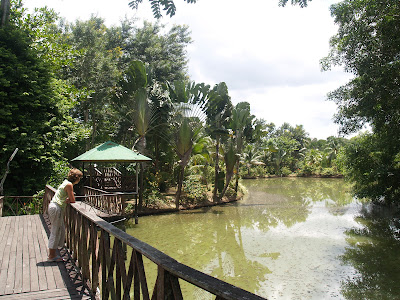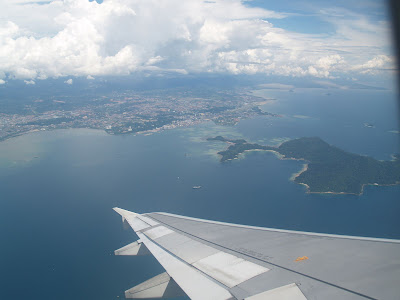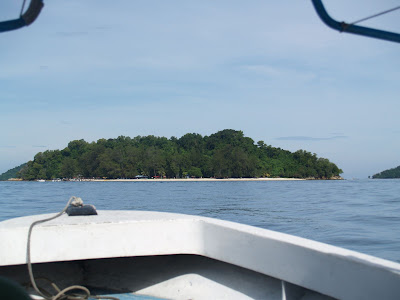Tunku Abdul Rahman National Park Three days in Brunei We left Brunei to tread new territory of Malaysia. After a short flight of half an hour, we landed at the airport Kota Kinabalu (KK) the capital and largest city of the State of Sabah , north of the island of Borneo .
is a city geared not difficult, and is about Tun Razak Julan Street, parallel to the wharf, where most activity is concentrated.
Although KK did not recognize him too attractive, has the privilege of being only 83 kilometers from Mount Kinabalu , with its 4,095 meters of altitude is the highest mountain in Southeast Asia , declared World Heritage by UNESCO along with the Kinabalu National Park, which is a part. The rise not easy for those not ready physically, as in our case, and therefore rule out the idea of \u200b\u200bmoving there.
The word "Kinabalu" comes from Aki Nabalu in Malay means "the sacred place where the dead dwell" . That is the name that is named the former Jesselton, destroyed twice during World War II.
only stayed two nights in KK and use it as a city of passage way to Sandakan, Sepilok and then to the Kinabatangan River area and the truth is that we spend too much effort. There has beautiful colonial buildings and Kuching, and the charm of it but apparently is a city where life is good and the atmosphere is guaranteed. There are many restaurants and street food stalls near the pier, in the call waterfront which offers fish and seafood at reasonable prices, but plunging into the thick smoke that originates in the grids can be uncomfortable.
Beach Street in the alley winds breathed a very different restaurants and cafes will happen next to each other and share the road as a common space where you can hear live bands animate the evening. Another more widely recommended by most travelers tired of noodle and rice is the Little Italy restaurant. Not only foreigners flock to the Italian restaurant but, as we saw from long queues, the Malaysians also do the pizza & pasta.
Definitely, KK life is good, people go out and have fun ... this is the feeling that we get from the capital of Sabah in the short time we were there.
abandon But without seeing Sabah Mount Kinabalu. A week later when we returned from the Kinabatangan River, we fly back to KK to bind to the flight to Singapore. Although a mist used to cover the top, the gods were on our side and on the flight from Sandakan to Kota Kinabalu could behold the majesty of the sacred mountain, the great mass of granite sticking out above the dense jungle vegetation. Awesome!

Back in Kota Kinabalu We had only four hours before departing for Singapore ... forever if we had to waste at the airport. So, we left the luggage in the modest price of 5 RM per pack and ventured to know anything more than KK. We took a taxi to the Sabah Museum , a huge complex which recommended visit would take us all the time we had. It is a comprehensive museum that collects various information on the State of Sabah, especially the various ethnic groups that inhabit it, traditional costumes, coins, ceramics, antiques and other objects scattered in two plants. A special section called time tunnel, collect the fingerprints of the History of Sabah through the colonial era, by World War II until its independence in 1963 and accession to the Federation of Malaysia. In the exhibit hall is the huge skeleton of a whale that beached on the nearby island Pulau Gaya a few years ago and is registered even in the Guinness Book of Records.
One of the most enjoyable is called Heritage Village located in a large gardens which is reached by crossing a lake full of water lilies (and mosquitoes) on a suspension bridge. Not as tourism as the Sarawak Cultural Village, follows the same style: Different models of tribal housing, as kazadan bamboo houses, a farm china, a typical house of Brunei, some longhouses, huts where sugar cane processing or resin ... a really fun place to spend a few hours.
One of the most requested trips from Kota Kinabalu, both for tourists and locals are visiting the National Park islands Tunku Abdul Rahman (TAR). The park consists of five islands: Manukan, Gaya, Sapi, and Sulug Mamutik and reefs that separate them, in a total of 49 km2. The proximity to town makes it a good place to go and spend the day, it is advisable avoid the weekend if one likes the quiet.
Despite this wise, it was Saturday the day we visited the National Park. Several groups of friends, families with children and some tourists, we had the same idea that hot Saturday in July. Advise leaving the hotel receptionist, we chose the two smaller islands: Pulau Sapi and Pulau Mamutik. As we said, Pulau Manukan is the most popular to be offered a wider range of services.
Getting to the islands is very easy and everything is well organized and assembled to tourists. You reach any of them in boats that leave from the ferry terminal point Jefreys . The terminal building is purchased ticket to visit the islands of interest and also pay the required fee. There you can rent snorkeling equipment.
In less than 15 minutes and we were on Pulau Sapi , a small island of only 0.1km2. Upon arrival, we pay 10RM per person for the conservation of National Parks (6RM for children under 18 years) that allow access to other islands. It is the little sister of Pulau Gaya to which you can walk at low tide. It has a small restaurant and the possibility of many activities. After quarters, we jump to snorkel without much success. Its clear waters showed a badly damaged coral bottom. I was disappointed to find enough dirt, empty cans, pieces of broken bottles ... a real shame.
In the small little beach near the pier is where it is most people but
the rest of the island is practically deserted and worth a bit away to enjoy peace of mind.
At 12 left with the boy in the boat that we would pick up on Pulau Sapi Pulau bring us to Mamutik that only 6 hectares is the smallest island of the five, one lap around the island takes less than 20 minutes.
Despite its small size, also has some services. It has beautiful beaches and they say, the best coral reefs on the east bank. It was the second time we practiced snorkeling, the first was in Belize and is like comparing an egg to a chestnut, but in Pulau Mamutik experience was much better than in Pulau Sapi. Another incentive was to see some of the huge but harmless monitors that inhabit the island. It was not hard to meet them as they approach the beach to find scraps of food containers. These large reptiles that can reach 3 meters are characterized by having a large jaw and a long tongue, like a snake's olfactory used as a means to find prey or detect threats. They feed on insects and invertebrates, but its insatiable appetite forced to eat anything. In fact, monitor lizard is the common name given to this kind of lizards that includes 30 different species, being the Komodo dragon lizard the world's largest.




An unexpected afternoon rain ended our day at the beach National Park Tunku Abdul Rahman.



































































